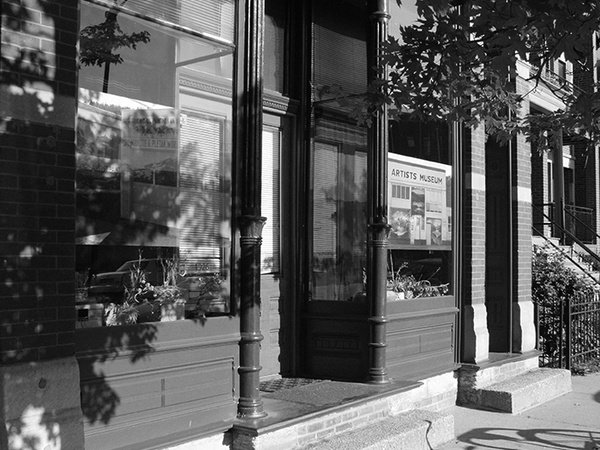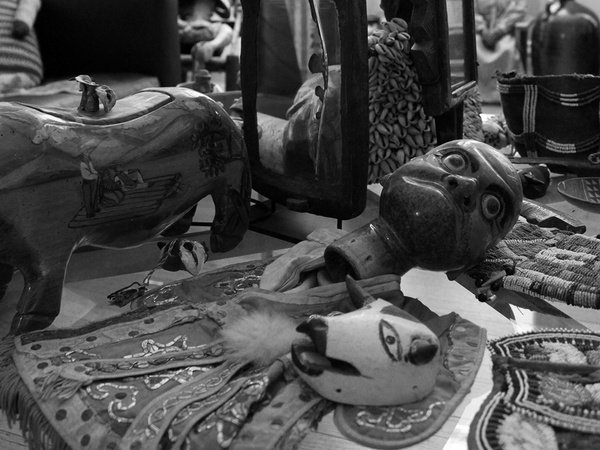Roger Brown Study Collection
The Roger Brown Study Collection of the School of the Art Institute of Chicago is a place for object studies and wonder. Entering the collection, visitors are treated to a kaleidoscopic glimpse of things from many genres and origins, arranged by Brown as an artists' museum.
1926 North Halsted Street
Chicago, IL 60614
773-929-2452
This house museum is available for events.
Tours by appointment only.
-
Beloved Bulldogs
Roger Brown’s bulldogs (Duchess, Babe, and Elvis, successively) were beloved companions who shared his home, studio, and affections. Their traces remain in dog dishes, chew toys, and nose marks on the walls. Bulldog images are tucked into the collection here and there, and appear in a few of Brown’s works.

-
Modernism and Classicism Unite!
The 1888 brick storefront at 1926 North Halsted Street retains many original architectural features. Roger Brown’s partner, Modernist architect George Veronda, sensitively rehabbed the interior in 1974, creating a spacious studio and residence to house an extensive art collection. In Veronda’s design, vintage architectural details harmonize within a Modernist scheme, creating a comfortable historical continuity.

-
Paper Trail
The Roger Brown Study Collection archive offers insights into Brown’s life through materials that vary from “strictly business” to deeply personal items. The archive reveals how integrally his physical and professional life reflected his philosophy and were expressed in his work, often in surprising and unexpected ways.

-
The King of Rock ’n’ Roll
Roger Brown was deeply connected with his roots. Early interest in family origins flowered into extensive genealogical research; tracing his autobiographical path became an obsession. Genealogical discoveries—like finding he was related to Elvis Presley—were woven into many paintings, and family relics are tucked into corners of the Roger Brown Study Collection.

-
An Artists’ Museum
Brown’s “Artists’ Museum of Chicago” features a carefully composed mélange of art by Chicago Imagists and self-taught makers, folk and tribal objects, popular culture, costumes, textiles, furniture, toys, advertising ephemera, souvenirs, and a Ford Mustang in the garage. All of them are touchstones that fueled Brown’s intense and demanding creative practice.

-
Home Economics, House Museum Style
Storage space is rare at the Roger Brown Study Collection. Thus, the gift shop is tucked into the dishwasher, while kitchen cabinets hold Brown’s 1970s appliances and an array of vintage, sugary foodstuffs. There’s Mrs. Butterworth’s syrup, Hershey’s cocoa, Karo syrups both light and dark, Brer Rabbit molasses, buttery caramel sauce, and clover honey––a core sample of a Southern-born artist's favorite sweeteners.

-
This Boy’s Own Story
Early in life Brown recognized his attraction to boys and men. His art explored sexuality in many guises, from erotic landscapes, sex in the city, HIV/AIDS, love, longing, joy, and loss—all infused with an uncanny sense for life’s complexities.

-
A Life Well Spent
What to do with that pocket full of change at the end of the day? Dump it on the nightstand, of course. Roger Brown’s pennies, nickels, dimes, and quarters spill out of a glass ashtray, right next to an oddly empty piggy bank. Guests are drawn to the dusty copper and silver coins, which serve as ordinary––but somehow priceless—reminders of daily life well spent.

-
Backyard Garden
Brown’s garden delightfully conjoins classical and vernacular features. Grand concrete statues of Neptune and Persephone preside over jardinière and English garden furniture, all resting on pavers that radiate around the catch basin cover. Junipers evoke Italian landscapes, and a domestic garage enshrines Brown’s 1967 Ford Mustang.

-
Here’s to Forever
The timeline of 1926 North Halsted is its lifeline. The building began its life as a tobacconist shop, and later housed a bookbindery, confectionary, grocery, and plastics company. Later, it became the home and studio of a famous artist; now, it is an artists’ museum where the rules of playing house/museum are being rewritten.

-
Thing Power
Many objects in the collection have particular power. Prehistoric stone tools, Roger Brown’s baby shoe, his great grandfather’s naval band and umbilical cord, a West African tribal hunter’s shirt, and other such things occupy most of the physical space—and all of the psychic space—of the Roger Brown Study Collection.

-
Vehicles of All Shapes and Sizes
Small-scale vehicles of all stripes are parked throughout the Roger Brown Study Collection. Just to name a few, renderings of transport appear in toys, models, carved balsa concept cars, in ceramic planters, and on a 1960s lunchbox. The real thing––Brown's 1967 Ford Mustang––is parked in the garage, waiting for guests to sink into its bucket seats, inhale the aroma of vintage leather, embrace the quiet, and imagine turning the key


